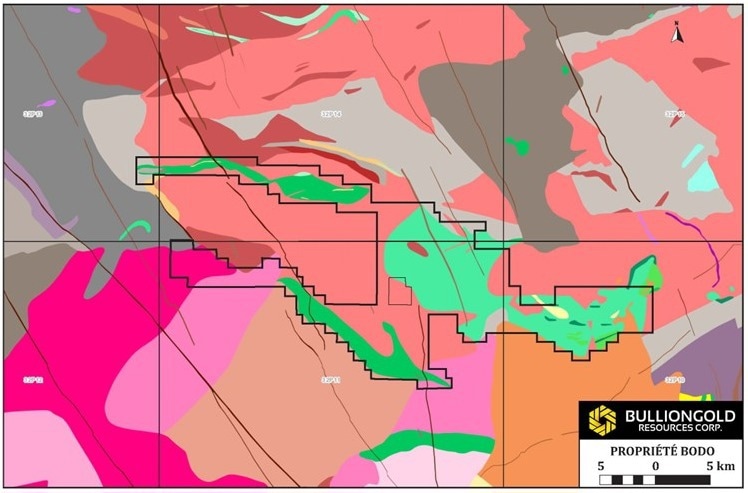Bullion Gold Resources Corp declares the acquisition, by way of staking and from a prospectors team, of 36,320 contiguous hectares developing the Bodo SM property, situated nearly 200 km north of the municipality of Chibougamau and nearly 100 km south of the Eastmain mine.
 Bodo SM Geological Map. Image Credit: BullionGold Resources Corp.
Bodo SM Geological Map. Image Credit: BullionGold Resources Corp.
Made of 682 cells, the Bodo SM project was acquired depending on its ability to hold spodumene pegmatites, the existence of a bedrock mostly denuded of vegetation, and its location that provides decent accessibility as a result of its vicinity to the main road heading to Chibougamau.
The geological environment of Bodo SM seems identical to that discovered in the known geological zones consisting of lithium in the western part of James Bay. In the past decade, the lithium deposits found have been in greenstone belts in contact with enormous granite intrusions. Thus, the Company has staked one of the last available greenstone belts that are accessible in a simple manner.
We had been looking for a geological sector integrating greenstone units in contact with vast pegmatite batholiths which are favorable to exploration for lithium and other strategic minerals. The Lake Baudau region offered this opportunity.
Mr. Jonathan Hamel, President and CEO, Bullion Gold Resources
Hamel continued, “With Bodo SM, we now hold 100% interest, without royalty, in a vast mining project located approximately 200 km north of Chibougamau, an important mining region.”
“The Lac Baudau sector could become, in our opinion, another favorable area for the discovery of lithium or other strategic minerals. Also, according to the International Energy Agency (IEA), global demand for lithium will be multiplied by 40 by 2040,” added Hamel.
The Bodo SM property spans most of a set of greenstone bands in contact with huge pegmatite granodiorites and granite batholiths. The three main greenstone units are composed of amphibolite basalts with a length differing from 20 to 28 km by a width ranging from 2.23 to 8 km.
Several granite and granodiorite batholiths bordering such volcanic units would contain, as per the MERN, various pegmatite dykes of different thicknesses. Still, no severe work has been done to determine the minerals in those visited and referred to in the RG-144 report dating from 1971.
But minerals like muscovite, tourmaline, or biotite have been noted in the granites that have been visited. Pegmatites consisting of minerals like lepidolite, spodumene, and petalite are frequently linked to mica minerals like muscovite and biotite, as well as silicate minerals like tourmaline.
Generally, pegmatites are developed from silica-rich magma that has crystallized gradually, enabling rare minerals to be crystallized. Other minerals searched for in link with the possible existence of lithium are rubidium, beryl, and cesium.
Also, ALS Goldspot Discoveries will take part in the analysis of present and future available data to outline the best targets to out once the property turns accessible in the spring of 2023.
Overall, there has been very little exploration work performed in this area. Hence, there is not a lot of geophysical and geological data besides those referred to in the several MERN reports. There is a Cu-Au-Ag and Mo showing (Rivon-Ouest) on the eastern property’s edge.
The claims acquired from a prospectors team were acquired in return for 1,100,000 shares of the Company. No royalty was provided to this team.